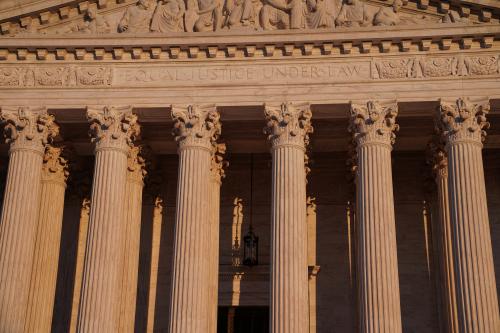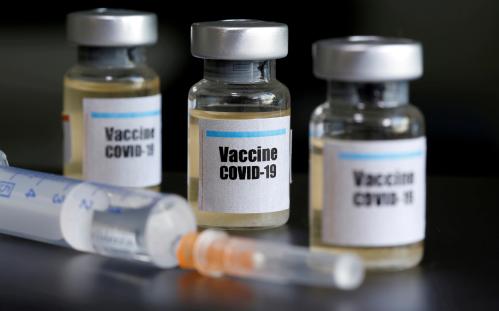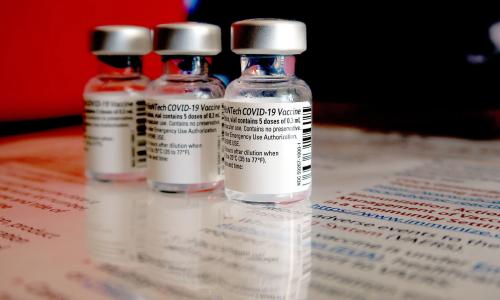The omicron wave of the COVID-19 virus has the new year off to a bad start, as infections soar throughout the country. Moreover, in the wake of the Supreme Court’s decision overturning the Biden administration’s vaccine mandate for employers with at least 100 employees, the best the administration might be able to do to boost vaccination rates, according to the concurring opinion in that case, is to narrow that mandate to those industries where the risk of contracting COVID-19 on the job are especially great. The administration could also strengthen its calls for states to impose mandates of their own, though with its currently diminished political capital and the already politicized nature of vaccine debate, this option may be of limited value.
But there is one sign of hope that so far has been flying under the radar: The potential development of a “universal” coronavirus vaccine—one that could eventually inoculate those who take it against most conceivable coronavirus variants, even including the common cold. In late December, it was reported that scientists at the Walter Reed Army Institute of Research were expected to announce that they had developed what appears to be a variation of such a vaccine, one that is effective against COVID-19 and all its variants, even omicron, as well as “previous SARS-origin viruses that have killed millions of people worldwide.” However, it is not clear that the Army’s vaccine will amount to a truly universal vaccine, one that prevents all future types of coronaviruses and that is long-lasting, much like current inoculations for polio, measles, and other diseases. Multiple other research efforts are under way to accomplish this more ambitious objective, funded by the National Institutes of Health and by a nonprofit based in Oslo, Norway, the Coalition for Epidemic Preparedness.
The challenge I address here is how to ensure enough people take that vaccine, if it arrives, to achieve herd immunity from any future coronaviruses. The huge difficulties the U.S. has had in getting Americans to take existing COVID-19 vaccines highlight the need to craft a vaccination plan now, well before a universal vaccine is here. Those difficulties will only be heightened if a truly universal vaccine is approved and enters the market at a future time when COVID-19 has abated markedly or burnt out. At that time, the public may not feel any urgency to take the shot, even if it were to confer long-lasting immunity from a broad range of viruses, which would in turn would provide broad health and economic benefits to the country for years or even decades. Likewise, in the absence of a true emergency, a future administration may find it difficult to convince the Supreme Court of a vaccine mandate’s necessity, even if it was designed narrowly with the Court’s recent ruling in mind.
How, then, could a future administration assure widespread vaccine take-up for a truly blockbuster universal vaccine in the highly polarized environment that is unlikely to change materially any time soon? There is one possibility, which I suggested in August 2020 and which many have debated since then: Pay those who choose to be vaccinated. I offered $1,000 then as a rough estimate of the larger payment that it would take to induce vaccine fence-sitters to take the shot.
But I couldn’t advocate then, given the true emergency the country was facing, that the government run a “gold-standard” experiment to find out the precise dollar amount to pay those who get vaccinated—namely, a randomized control trial (RCT). In an RCT, one group of people is randomly chosen to receive a treatment, and a separate control group is given a placebo. In the case of vaccine payments, different treatment groups would have been offered payments of various sizes to determine which payment was most effective at incentivizing vaccination. To have done that in December 2020, when the first COVID-19 vaccine, made by Pfizer, was given an “Emergency Use Authorization” by the Food and Drug Administration (FDA), would have been an ethical and political non-starter.
I nonetheless advocated the $1,000 payment precisely because of the national emergency, on the view that it would be better for the country to err on the side of doing too much than too little. I estimated the cost of doing this at around $275 billion, and though I recognized that the payment would be “wasted” on those who otherwise were inclined to take the shot, I argued that the stakes involved—getting the economy back on its feet and saving large numbers of lives—that “waste” would be worth it. I also proposed having the government pay for vaccinations to avoid what I feared then would be the politically divisive step of mandating the vaccines.
Of course, that is what happened when the Biden administration mandated that large employers and health care organizations vaccinate their workers. After lower court challenges, the Supreme Court upheld only the health care organization mandate on January 13. As a result of the Court’s ruling, policy makers cannot count on a broad mandate being used in the future to ensure a high take-up of a universal coronavirus vaccine.
Meanwhile, since I advanced the payment for vaccine idea, there has been a vigorous debate about its merits. There have also been a few surveys about peoples’ willingness to take the vaccine if paid to do so. For the most part these surveys of actual vaccinations, not just intentions, have tested much smaller payments than the proposed $1,000 payment, instead in the $100 or less range. The results have been mixed, which is not surprising, because payments of small amounts should not be expected to change the minds of many of those who are vaccine hesitant.[1]
In any event, the timing was never right for the initial proposal to pay people to take the COVID-19 vaccine. It was unlikely that either President Trump or Congress would have considered the idea in the fall of 2020, before the Pfizer vaccine was approved for emergency use in December. After the election, Trump’s proposed unconditional $2,000 COVID relief payment for most Americans proved so popular that President Biden and Democrats endorsed the idea, although it didn’t become law until March 2021 (by that time with large Republican opposition). In theory, the funding for vaccine payments could have been made part of the $1.9 billion relief package since the FDA by then had already given emergency approval to all three major vaccines, but as a political matter it was too early to offer the conditional payments. The Biden administration had been in office for less than two months and had just begun its public campaign urging people to voluntarily be vaccinated. It is understandable why the administration would not have wanted to turn so quickly to paying for vaccinations without at least trying an education and persuasion campaign first.
Predictably, however, given our politically polarized country, that effort failed to get the vaccination rate even just for adults to 70 percent on the timeline set out by the Biden administration (though this milestone for at least one shot was later reached by the end of July 2021). Again, in theory, the administration could have tried during the rest of last year to get something like the $1,000 payment into either what became the bipartisan infrastructure plan (which is now law) or the Build Back Better (BBB) initiative, which has ignited a bitter fight among Democrats that is yet to be resolved. Given the long list of “must have” programs in the initiative and the limited means to pay for them, it is understandable why the Biden administration or Congressional leaders would not have wanted to insert an expensive vaccination payment program into the BBB mix.
In short, the timing has not been right during these past 18 months for federal approval of vaccination payments. In the meantime, vaccine hesitancy seems to have hardened considerably, despite the successive waves of the virus and climbing death toll.
Moreover, because the pandemic is global and even travel bans cannot fully stop the virus from jumping country to country, had a one-time payment been highly successful in bringing the U.S. to herd immunity from the initial COVID-19 virus, it would not have prevented more transmissible variants—such as delta and now omicron—from raising the herd immunity bar and thus continuing to infect Americans. Still, I continue to believe fewer people would have been infected and died throughout these waves of the virus if the vaccination payment system had been in place all along.
The potential advent of an FDA-approved universal coronavirus vaccine, if this should happen, would change everything. If a universal vaccine is developed and approved, and evidence suggests that it would afford long-lasting protection like other vaccines, then it would be not just possible but essential to conduct an RCT before the vaccine is widely distributed (assuming that the country is not in a state of emergency due to another coronavirus at that time). The RCT would be designed to test whether and to what extent different payment amounts influence vaccine take-up. The objective of the RCT would be to establish for policymakers an “effectiveness curve” with size of payments on the horizontal axis of a graph and increased take-up rates, measured in percentage points of the population, on the vertical axis. In other words, policymakers would know—if there is a positive relationship between the amount of payment and vaccination take-up—how much additional benefit society would gain for an incremental increase in payment amounts.
My hypothesis, subject to confirmation, is that the incremental gains to society would be worth the price over some range of payments—say $100 to $1,000—but then show diminishing returns as the payments get substantially higher. With a sample stratified by age, income, education, and race, policy makers could also learn what the differential impacts of different sized payments would be on people in these different demographic categories.
As with my original argument for COVID-19 vaccine payments, any payment for taking the universal coronavirus vaccine would be given both to those who would take the vaccine without the payment and those for whom the payment makes the critical difference. That means there would be some “waste.” The question is whether the waste would be worth it. That is, would the benefits of the payment—reduced death, medical costs, and economic interruption—outweigh the costs? If the answer to that question is yes, then policymakers would have evidence-based grounds to authorize such a one-time payment, though legitimate debate might still exist over the appropriate amount.
Paying people to take a universal vaccine in a non-emergency would change the calculus on how it should be financed. Deficit financing is appropriate during a true emergency, especially when national output and employment are falling, as was the case back in 2020. But in a non-emergency situation, payments are much more like a permanent investment in human and economic resilience. In principle, such investments should be financed with matching tax revenue (even if spread out over multiple years).
Some will object to having the government pay anything for the universal COVID vaccine, on any one of multiple grounds, including the precedent it would set for other expectations of payment for other vaccines. If we had far greater national unity and trust in science and medical expertise than we have now, I would side with the objectors.
But alas, as much as many in our country long for greater trust in science, those days are gone. We are where we are. And in today’s environment, and likely the political environment when the universal vaccine becomes available, we all will be better off at least knowing, with the kind of hard evidence than an RCT can provide, whether vaccination payments work, and if so, in what amounts. If the amounts are reasonable—say $1,000 per person or less—and they make a real difference in a sampled population, I for one would be ready to pay whatever (small) amount of additional, perhaps temporary, tax increase to finance vaccination payments for the entire country. I strongly suspect and hope that a majority of Americans would agree.
Robert Litan is a non-resident Senior Fellow in the Economic Studies Program at the Brookings Institution, a program he formerly directed.
The Brookings Institution is financed through the support of a diverse array of foundations, corporations, governments, individuals, as well as an endowment. A list of donors can be found in our annual reports published online here. The findings, interpretations, and conclusions in this report are solely those of its author(s) and are not influenced by any donation.






Commentary
Op-edWhen a universal coronavirus vaccine arrives, we should test payments for vaccine recipients
January 26, 2022